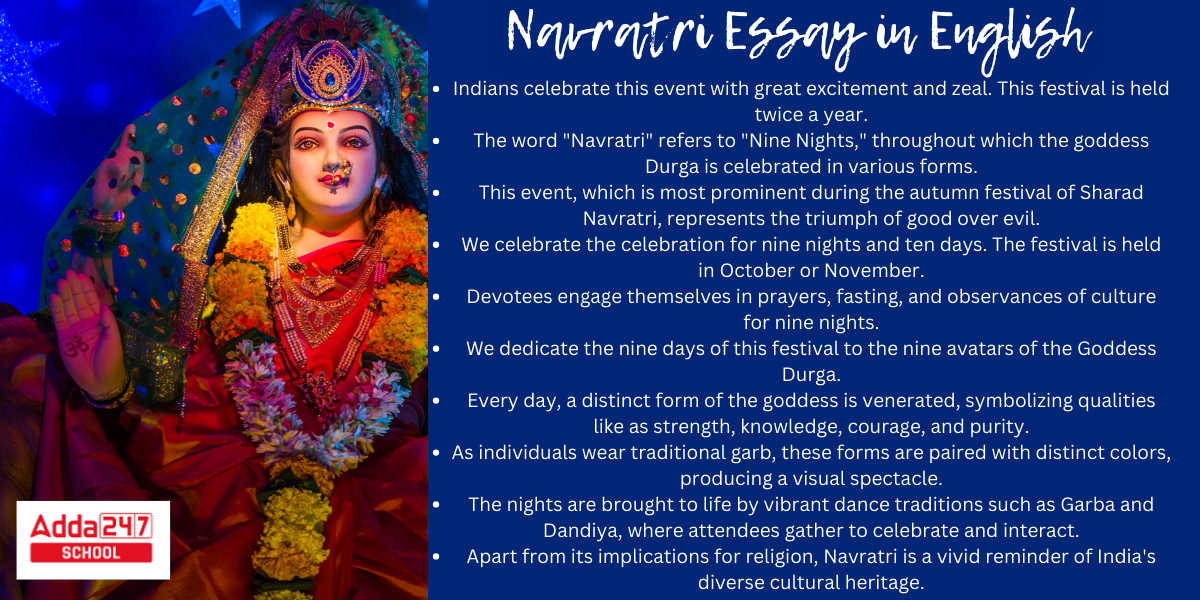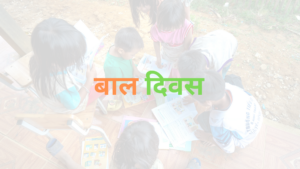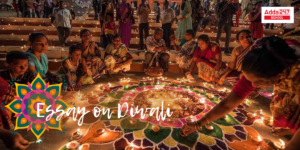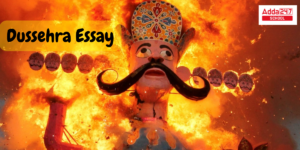Navratri Essay in English: The Navratri Essay in English is a colorful but interesting topic that you may find relevant throughout this festive season. Writing an essay on Navratri during the holiday season might help students understand more about one of Hinduism’s most important festivals. Navratri is a Hindu festival celebrating Goddess Durga and her different incarnations. Navratri celebrates the triumph of good over evil and light over darkness. In the Gregorian calendar, it usually happens in September or October. During this time, homes and temples are decked with vibrant rangoli designs, and special offerings to the goddess, such as fresh flowers and sweets, are prepared.
Navratri Essay in English
There is a lot of unknown and interesting information in these sample Navratri essays in English. You can create your own essay on Navratri Essay using these brief sample essays. The word Navratri is broken into two words: ‘Nav‘, which means nine, and ‘Ratri‘, which means night. It is a major event in Maharashtra, West Bengal, and Gujarat, but it is celebrated worldwide.
The Navratri celebrations last nine nights and ten days. Dussehra is the final day of the celebration. People fast and go to the Goddess temples to express their appreciation and devotion. Because the celebration purges negativity, it is thought that economic success and good well-being will begin to flow. People of different ages are devoted to showering them with gifts and sweets.
10 Points on Navratri
Read Here are 10 points on Navratri:
Meaning: Navratri means “Nine Nights” in Sanskrit, symbolizing the nine days of worship and celebration dedicated to Goddess Durga and her various forms.
Duration: Navratri is celebrated twice a year—Chaitra Navratri (in March/April) and Sharad Navratri (in September/October), each lasting nine days.
Religious Significance: The festival honors the victory of Goddess Durga over the buffalo demon Mahishasura, representing the triumph of good over evil.
Worship of Different Forms: Each day of Navratri is dedicated to a different form of Goddess Durga, including Shailaputri, Brahmacharini, Chandraghanta, Kushmanda, Skandamata, Katyayani, Kalaratri, Mahagauri, and Siddhidatri.
Fasting: Many devotees observe fasting during Navratri, consuming only satvik (pure) food like fruits, dairy, and specific grains, while avoiding meat, alcohol, and garlic.
Garba and Dandiya: In many parts of India, especially in Gujarat, people participate in Garba and Dandiya Raas—traditional folk dances performed in colorful attire during the evenings.
Kanya Pujan: On the eighth or ninth day (Ashtami or Navami), young girls, symbolizing the Goddess, are worshiped and offered food, clothes, and gifts as part of Kanya Pujan.
Regional Variations: While the essence of Navratri remains the same, celebrations differ regionally. For example, in West Bengal, it coincides with Durga Puja, a major festival focusing on elaborate rituals and processions.
Spiritual Importance: Navratri is not just a time of festivities but also a period for spiritual renewal, meditation, and self-discipline, with many people taking time for personal reflection.
Dussehra: The festival culminates on the 10th day, celebrated as Dussehra or Vijayadashami, marking the victory of Lord Rama over the demon king Ravana, another symbolic representation of good defeating evil.
Navratri Essay in 10 Lines
Here is an easy but informative Navaratri Essay in English, 10 lines are given below.
- Indians celebrate this event with great excitement and zeal. This festival is held twice a year.
- The word “Navratri” refers to “Nine Nights,” throughout which the goddess Durga is celebrated in various forms.
- This event, which is most prominent during the autumn festival of Sharad Navratri, represents the triumph of good over evil.
- We celebrate the celebration for nine nights and ten days. The festival is held in October or November.
- Devotees engage themselves in prayers, fasting, and observances of culture for nine nights.
- We dedicate the nine days of this festival to the nine avatars of the Goddess Durga.
- Every day, a distinct form of the goddess is venerated, symbolizing qualities like as strength, knowledge, courage, and purity.
- As individuals wear traditional garb, these forms are paired with distinct colors, producing a visual spectacle.
- The nights are brought to life by vibrant dance traditions such as Garba and Dandiya, where attendees gather to celebrate and interact.
- Apart from its implications for religion, Navratri is a vivid reminder of India’s diverse cultural heritage.
Navratri Essay in 100 Words
Millions of people in India and around the world cherish Navratri, one of the most renowned Hindu holidays. Navratri is a colorful Hindu festival that lasts nine nights and ten days and symbolizes the victory of good over evil. It’s a moment for people to gather together as the air fills with music and dancers swirling in time. During Navratri, the goddess Durga is worshipped in various forms, each representing a unique characteristic. It embodies the essence of unity, spirituality, and the divine feminine’s enduring strength. Devotees fast, visit temples, and take part in traditional activities such as Garba and Dandiya dances. The event keeps growing, preserving traditions and instilling a strong feeling of ethnic pride.
Navratri Essay in English 150 Words
Navratri is a Hindu holiday observed in India and Nepal. It is a nine-night celebration consecrated to the veneration of the goddess Durga and her various manifestations. In accordance with the Hindu calendar, the festival takes place in the month of Ashvin.
Every one of the nine nights of Navratri is devoted to a distinct form of the goddess Durga, and specific prayers and rituals are carried out to honor her.
Many Hindus observe Navratri as a time of fasting and devotion. During the festival, people refrain from consuming specific foods, including flesh and alcohol, and prefer to concentrate on spiritual practices and worship. The Garba, a traditional form of dance performed throughout the festival, is a key component of Navratri.
Navratri is also honored with the exhibition of colorful decorations and lights, in addition to the Garba. Colorful rangoli patterns beautify homes and temples, and individual offerings are presented to the deity.
Short Essay on My Favourite Festival Navratri
Navratri is one of my favorite festivals, celebrated with great enthusiasm and devotion across India. This vibrant nine-day festival, dedicated to Goddess Durga, symbolizes the triumph of good over evil. It usually takes place in the months of September or October, depending on the lunar calendar. The word “Navratri” itself means “nine nights,” and each of these nights is dedicated to one of the nine forms of the Goddess.
One of the most exciting aspects of Navratri is the Garba and Dandiya dances, which are performed every night during the festival. People dress in colorful traditional outfits and gather to dance in circles, moving to the rhythm of folk music. The atmosphere is filled with joy, energy, and togetherness, making it an unforgettable experience. I enjoy participating in these dances, as it brings me closer to my culture and allows me to share in the community’s spirit.
During Navratri, many people observe fasts and offer prayers to the Goddess. Special pujas are conducted in homes and temples, and devotees seek blessings for happiness and prosperity. It is a time of spiritual reflection and purification, as people abstain from certain foods and focus on self-discipline.
The ninth day, Mahanavami, and the tenth day, Dussehra, mark the conclusion of the festival. Dussehra celebrates Lord Rama’s victory over the demon king Ravana, reinforcing the theme of the triumph of good over evil. It is also a time to burn effigies of Ravana, symbolizing the destruction of evil.
Navratri holds a special place in my heart because of its rich cultural significance, the joy it brings to families, and the way it unites communities in celebration. For me, it is not just a festival but a time to reflect on the importance of inner strength, devotion, and moral values, which are the essence of Goddess Durga’s power.
Navratri is a festival that fills me with immense joy, pride, and a sense of spiritual upliftment. It beautifully blends tradition, devotion, and celebration, making it my favorite festival.
My Favourite Festival Navratri Essay in English (Long)
The Navratri festival is a joyful means of honoring Goddess Durga. The symbolic significance of ‘Nav’ is nine, and the literal meaning of ‘Ratri’ is darkness. As a result, the festival gets its name since we commemorate it over nine nights. The celebration features vibrant costumes, traditional music, and frenetic dancing.
The goddess’s nine forms are associated with various colors, and each day represents a different attribute. Sharad Navratri, which occurs in the autumn, is the more well-known of the two Navratri seasons. The nine days of this festival are dedicated to the Goddess Durga’s nine incarnations. She is the first-day manifestation of the goddess Parvati. On her ninth day, she remains on a lotus, exuding nature’s wisdom and beauty. The color of the last day is light blue.
Navratri promotes solidarity and cultural pride by bringing communities together. Devotees fast, pray, and visit temples in order to obtain blessings and gain spiritual insight. The Navratri festival crosses religious barriers and has meaning for individuals from all walks of life. Ultimately, Navratri brings people from all around the country together and represents diversity and culture.
This festival celebrates the strength of women, spirituality, and India’s diverse cultural history. Navratri remains a treasured and appreciated tradition, preserving its cultural and spiritual significance.
Navratri Speech in English
It is with great joy and reverence that we gather here today to celebrate the auspicious occasion of Navratri. Navratri, the festival of nine nights dedicated to the worship of Goddess Durga, holds immense significance in Hindu culture and traditions. It is a time of spiritual renewal, cultural exuberance, and communal harmony.
Navratri symbolizes the triumph of good over evil, light over darkness, and knowledge over ignorance. As we embark on this nine-day journey, we are reminded of the divine feminine power that resides within each of us. The nine forms of Goddess Durga, worshipped during Navratri, embody different facets of strength, courage, and wisdom, inspiring us to overcome obstacles and embrace positivity in our lives.
During these auspicious days, devotees across the world observe fasts, perform rituals, and engage in devotional practices to seek the blessings of the Goddess. It is a time for introspection, purification, and spiritual growth. Through prayers and offerings, we express our gratitude for the abundance of blessings bestowed upon us and seek guidance on our spiritual journey.
Navratri is also a celebration of culture and community. The vibrant Garba and Dandiya Raas dances, performed in colorful attire, reflect the unity and joy of the festive season. These lively gatherings bring people together, irrespective of caste, creed, or background, fostering a sense of camaraderie and social harmony.
As we immerse ourselves in the festivities of Navratri, let us not forget the underlying message of compassion, kindness, and tolerance. Let us extend a helping hand to those in need, embrace diversity, and uphold the values of unity and peace.
In conclusion, Navratri is more than just a festival; it is a sacred journey of self-discovery, cultural expression, and communal bonding. May this auspicious occasion fill our hearts with joy, our minds with wisdom, and our lives with prosperity. Let us celebrate Navratri with utmost devotion and fervor, keeping alive the timeless traditions and teachings of our rich heritage.
Thank you. Jai Mata Di!
Most Interesting Facts on Navratri Festival
Navratri is a significant Hindu festival celebrated over nine nights and ten days, dedicated to the worship of the Hindu deity Durga and her various forms. Here are 10 points highlighting the significance and practices associated with Navratri:
- Spiritual Significance: Navratri symbolizes the victory of good over evil. It is believed that during these nine nights, the divine feminine power (Shakti) manifests in different forms to destroy negative forces and restore peace and righteousness in the universe.
- Nine Forms of Durga: Each day of Navratri is dedicated to a different form of Goddess Durga, known as Navadurga. These forms include Shailaputri, Brahmacharini, Chandraghanta, Kushmanda, Skandamata, Katyayani, Kalaratri, Mahagauri, and Siddhidatri.
- Devotional Observances: Devotees observe fasts, perform puja (ritual worship), recite prayers, and participate in various religious ceremonies during Navratri. These practices are believed to invoke the blessings of the Goddess and purify the mind and body.
- Garba and Dandiya Raas: Navratri is famous for its vibrant and energetic dance forms, such as Garba and Dandiya Raas. People dress in traditional attire and dance in circles, accompanied by rhythmic music, to celebrate the festival with joy and enthusiasm.
- Cultural Celebrations: Navratri is not only a religious festival but also a cultural extravaganza celebrated with great fervor across India. It promotes social harmony and unity as people from different backgrounds come together to rejoice in the festivities.
- Regional Variations: Navratri is celebrated differently in various parts of India. In Gujarat and Maharashtra, it is marked with elaborate Garba and Dandiya Raas performances, while in North India, devotees observe fasts and organize elaborate puja ceremonies.
- Golu Display: In South India, particularly in Tamil Nadu and Karnataka, Navratri is celebrated as Golu or Bommai Golu. It involves the display of dolls and figurines arranged on steps, representing deities, historical events, and mythological stories.
- Culinary Delights: Special festive foods are prepared during Navratri, especially those that are sattvic (pure) and suitable for fasting. These include dishes made from ingredients like sabudana (tapioca pearls), kuttu (buckwheat), singhare ka atta (water chestnut flour), and fruits.
- Community Participation: Navratri brings communities together, fostering a sense of togetherness and camaraderie. Many temples and community organizations organize Navratri events, including dances, music performances, and religious discourses.
- Cleansing and Renewal: Navratri is also a time for introspection, purification, and renewal. It is an opportunity for individuals to reflect on their spiritual journey, overcome negativities, and strive for personal growth and enlightenment.
Overall, Navratri is a deeply revered festival that embodies spiritual devotion, cultural richness, and social harmony, making it a cherished occasion for millions of people worldwide.
Navratri Essay in English – Key Points
There are some pointers which are crucial and must be included in your Navratri Essay in English. We have prepare an essay on Navratri keeping these crucial points here under.
Introduction
Navratri: A Celebration of Devotion, Culture, and Triumph of Good over Evil. Navratri, meaning “nine nights” in Sanskrit, is one of the most significant and widely celebrated Hindu festivals across India and among the global Hindu community. The festival spans nine nights and ten days, during which devotees worship different forms of the Goddess Durga. It symbolizes the victory of good over evil and is marked by religious rituals, vibrant cultural events, and a deep sense of community and devotion.
Mythological Significance
Navratri commemorates the victory of Goddess Durga over the demon Mahishasura, who had gained immense power and threatened to bring chaos to the world. After a prolonged battle, Durga vanquished Mahishasura on the tenth day, celebrated as Vijayadashami or Dussehra, signifying the triumph of righteousness. The nine days of Navratri are dedicated to different aspects of the Goddess, each representing a unique power and energy: Shailaputri, Brahmacharini, Chandraghanta, Kushmanda, Skandamata, Katyayani, Kalaratri, Mahagauri, and Siddhidatri.
Regional Variations in Celebration
India, with its diverse cultures and traditions, celebrates Navratri differently in various regions, each adding its unique flavor to the festivities.
- Northern India: In the northern parts of India, Navratri is marked by fasting, prayers, and the staging of Ramlila – dramatic performances based on the life of Lord Rama, culminating in the burning of effigies of Ravana on Dussehra. This represents the victory of Lord Rama over the demon king Ravana, symbolizing the conquest of good over evil.
- Western India: Gujarat and Maharashtra are known for their vibrant Garba and Dandiya Raas dances. Garba involves devotional singing and dancing around an earthen pot symbolizing Shakti (the feminine energy). Dandiya Raas is a lively dance performed with sticks, signifying a mock battle between Goddess Durga and Mahishasura.
- Southern India: In Tamil Nadu, Andhra Pradesh, and Karnataka, families celebrate Navratri by setting up “Golu” – a display of dolls and figurines representing deities, mythological characters, and scenes from daily life. Women often exchange gifts, sweets, and perform special prayers during the nine days. In Kerala, the last three days are dedicated to Goddess Saraswati, and children often begin their education during this auspicious time, known as Vidyarambham.
- Eastern India: In West Bengal, Assam, and Odisha, Navratri transforms into Durga Puja, a grand festival where elaborate idols of Goddess Durga are worshipped in beautifully crafted pandals (temporary shrines). The festival culminates with the immersion of the idols in rivers or lakes, symbolizing the departure of the Goddess to her celestial abode.
Spiritual and Cultural Essence
Navratri is not just a religious festival; it also carries deep spiritual significance. It is a time for self-reflection, discipline, and reconnecting with one’s inner strength. Devotees often observe fasts, abstain from worldly pleasures, and dedicate themselves to prayer and meditation. The nine days are believed to be auspicious for spiritual growth, as the goddess energy (Shakti) is said to be at its peak during this period.
Moreover, Navratri also serves as a cultural platform where traditional music, dance, and arts come to the forefront. Communities come together to celebrate through various cultural programs, making the festival a vibrant and colorful spectacle. The festival brings people of all ages together, creating a sense of unity and joy.
Conclusion
Navratri is a festival that embodies the spirit of devotion, the celebration of feminine power, and the victory of good over evil. Whether through the serenity of prayers or the exuberance of dance and music, Navratri touches lives with its deep spiritual and cultural resonance. It is a reminder that through faith, perseverance, and unity, we can overcome any adversities in life, just as Goddess Durga overcame the forces of darkness.
Related Articles:









 बाल दिवस पर निब�...
बाल दिवस पर निब�...
 Essay on Diwali in English, Read Long an...
Essay on Diwali in English, Read Long an...
 Essay on Dussehra in English in 10 Lines...
Essay on Dussehra in English in 10 Lines...














